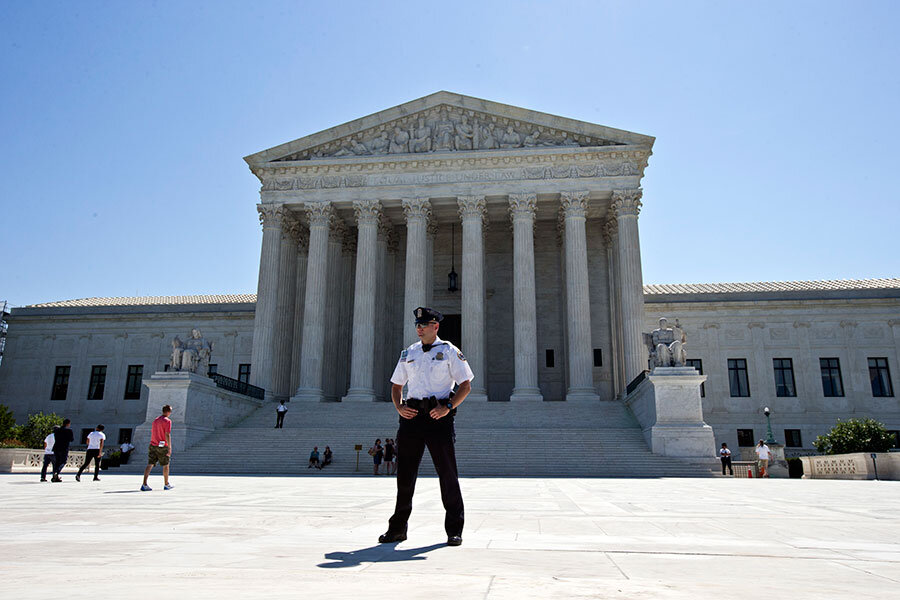Supreme Court lets stand state assault weapon bans, continuing trend
Loading...
The United States Supreme Court declined to hear two Second Amendment challenges to assault weapon bans in New York and Connecticut Monday.
The denials continue a years-long trend in which the justices have avoided taking up Second Amendment challenges, but through their denials sketch out what kinds of gun restrictions are constitutionally acceptable – and which are not.
In this instance the court has, for the second time in six months, given tacit approval of state-level restrictions on assault weapons.
The denials come at a poignant moment – just over a week after a gunman used a handgun and a semiautomatic assault-style rifle to kill 49 people at a gay nightclub in Orlando, Fla., the worst mass shooting in modern US history. Though the decision was made on dispassionate legal grounds, it appears to be aligned with public opinion.
"Lower courts have said that it’s within the discretion of [local] legislatures to enact these laws," says Eugene Volokh, a professor at the University of California, Los Angeles, School of Law. "Generally speaking the Supreme Court doesn’t step in to review a case unless there’s a disagreement in the lower courts."
Both challenges denied this morning – Shew v. Malloy, challenging Connecticut’s ban, and Kampfer v. Cuomo, challenging New York’s – had been dismissed by the US Court of Appeals for the Second Circuit.
The Connecticut law was passed in 2013 after the mass shooting at Sandy Hook Elementary School in Newtown, Conn., and bans more than 180 kinds of semiautomatic firearms and features. The New York law, enacted the same year, is modeled on Connecticut’s law but doesn’t list specific prohibited weapons.
The Second Circuit upheld the Connecticut and New York bans because they were specifically targeted to prevent mass shootings, writing in the Connecticut decision that "because the prohibitions are substantially related to the important governmental interests of public safety and crime reduction, they pass constitutional muster."
Whether such prohibitions are effective in preventing mass shootings is an open question – the laws are "banning the whiskeys, but allowing the vodkas," says Professor Volokh, permitting some firearms that are just as deadly as those banned. But seven states, including Maryland, California, and Hawaii, and several cities and towns have enacted such laws. Public support for a ban on assault weapons jumped to 57 percent after the Orlando shooting.
Still, the court has not heard arguments in a Second Amendment case since 2010, and has typically shied away from the issue since its landmark 2008 ruling in District of Columbia v. Heller, which, in a 5-to-4 decision, found that the Constitution protects an individual’s right to bear arms.
The court's denials since then set no precedent, and the justices offer no explanation for them. The only window into the court's thinking has come in occasional dissents by some justices.
For example, after the court in December declined to review a suburban Chicago case similar to the one declined Monday, Justices Clarence Thomas and Antonin Scalia said the decision "flouts" the court's previous rulings on the Second Amendment.
"The overwhelming majority of citizens who own and use such rifles do so for lawful purposes, including self-defense and target shooting," Justice Thomas wrote. "Under our precedents, that is all that is needed for citizens to have a right under the Second Amendment to keep such weapons."
The court hasn't completely avoided Second Amendment cases, however. Ever since the Heller decision, the justices have been staking out which weapons the ruling protects and how legislatures can regulate them.
In March, the court vacated a decision by the Supreme Judicial Court of Massachusetts to convict Jaime Caetano for violating the state’s ban on stun guns. Ms. Caetano had bought the weapon for protection against an abusive ex-boyfriend.
The stun gun conviction clearly contradicted the Heller ruling, the Supreme Court found.
Both the Heller decision and the 2010 decision in McDonald v. City of Chicago, which found that the Heller ruling applies in individual states, "indicated that the right to bear arms was not unlimited but was subject to reasonable restraints," writes John Vile, a constitutional scholar at Middle Tennessee State University in Murfreesboro, in an e-mail to the Monitor.
"Governments are now in the process of testing what restraints the Court will consider to be reasonable and which it will not," he added.








